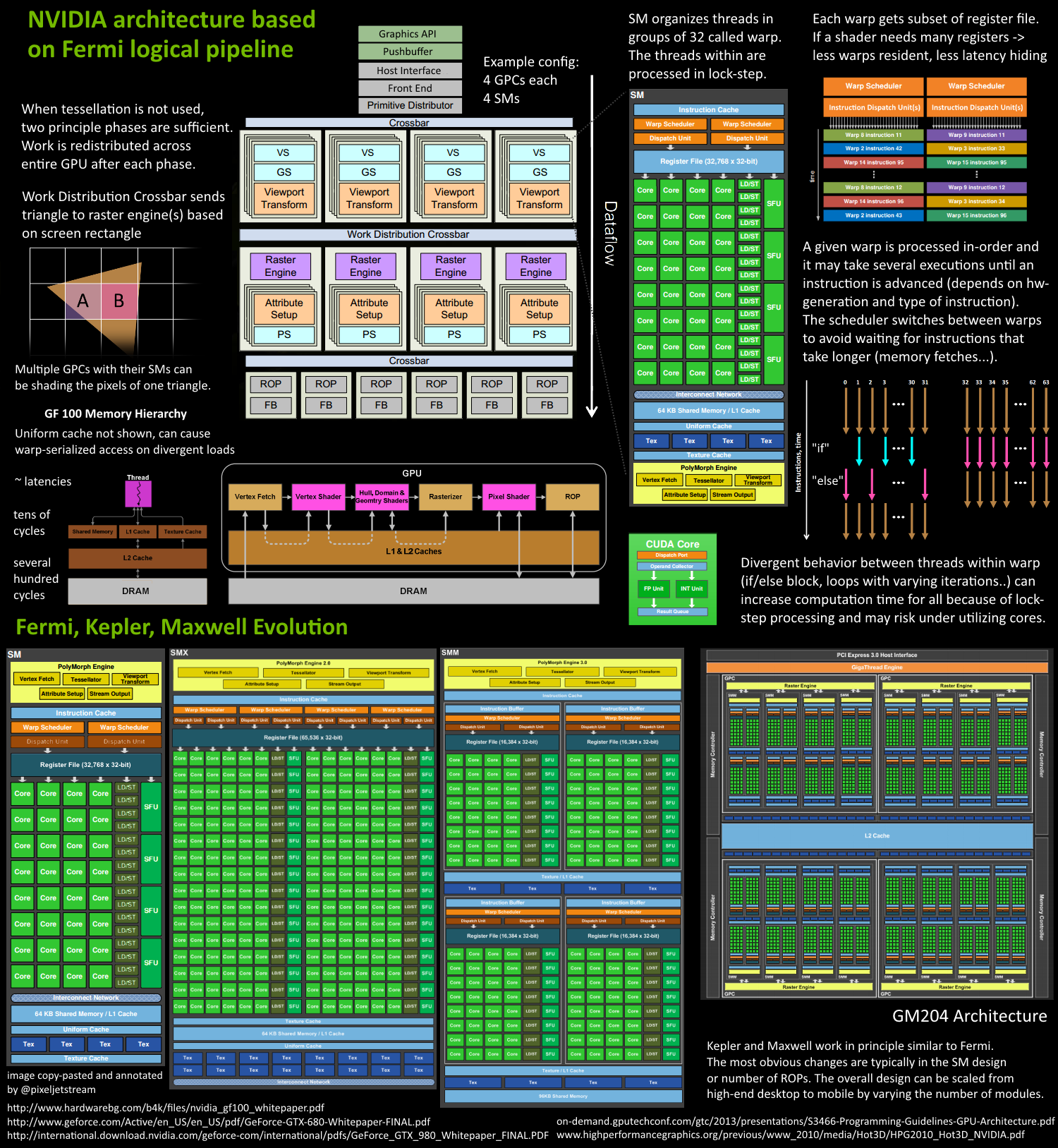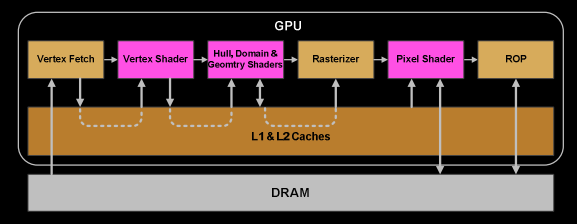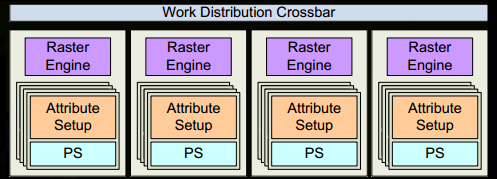Life of a triangle - NVIDIA's logical pipeline
Life of a triangle - NVIDIA's logical pipeline

Since the release of the ground breaking Fermi architecture almost 5 years have gone by, it might be time to refresh the principle graphics architecture beneath it. Fermi was the first NVIDIA GPU implementing a fully scalable graphics engine and its core architecture can be found in Kepler as well as Maxwell. The following article and especially the “compressed pipeline knowledge” image below should serve as a primer based on the various public materials, such as whitepapers or GTC tutorials about the GPU architecture. This article focuses on the graphics viewpoint on how the GPU works, although some principles such as how shader program code gets executed is the same for compute.
- Fermi Whitepaper
- Kepler Whitepaper
- Maxwell Whitepaper
- Fast Tessellated Rendering on Fermi GF100
- Programming Guidelines and GPU Architecture Reasons Behind Them
Pipeline Architecture Image

GPUs are super parallel work distributors
Why all this complexity? In graphics we have to deal with data amplification that creates lots of variable workloads. Each drawcall may generate a different amount of triangles. The amount of vertices after clipping is different from what our triangles were originally made of. After back-face and depth culling, not all triangles may need pixels on the screen. The screen size of a triangle can mean it requires millions of pixels or none at all.
As a consequence modern GPUs let their primitives (triangles, lines, points) follow a logical pipeline, not a physical pipeline. In the old days before G80's unified architecture (think DX9 hardware, ps3, xbox360), the pipeline was represented on the chip with the different stages and work would run through it one after another. G80 essentially reused some units for both vertex and fragment shader computations, depending on the load, but it still had a serial process for the primitives/rasterization and so on. With Fermi the pipeline became fully parallel, which means the chip implements a logical pipeline (the steps a triangle goes through) by reusing multiple engines on the chip.
Let's say we have two triangles A and B. Parts of their work could be in different logical pipeline steps. A has already been transformed and needs to be rasterized. Some of its pixels could be running pixel-shader instructions already, while others are being rejected by depth-buffer (Z-cull), others could be already being written to framebuffer, and some may actually wait. And next to all that, we could be fetching the vertices of triangle B. So while each triangle has to go through the logical steps, lots of them could be actively processed at different steps of their lifetime. The job (get drawcall's triangles on screen) is split into many smaller tasks and even subtasks that can run in parallel. Each task is scheduled to the resources that are available, which is not limited to tasks of a certain type (vertex-shading parallel to pixel-shading).
Think of a river that fans out. Parallel pipeline streams, that are independent of each other, everyone on their own time line, some may branch more than others. If we would color-code the units of a GPU based on the triangle, or drawcall it's currently working on, it would be multi-color blinkenlights :)
GPU architecture

Since Fermi NVIDIA has a similar principle architecture. There is a Giga Thread Engine which manages all the work that's going on. The GPU is partitioned into multiple GPCs (Graphics Processing Cluster), each has multiple SMs (Streaming Multiprocessor) and oneRaster Engine. There is lots of interconnects in this process, most notably a Crossbar that allows work migration across GPCs or other functional units like ROP (render output unit) subsystems.
The work that a programmer thinks of (shader program execution) is done on the SMs. It contains many Cores which do the math operations for the threads. One thread could be a vertex-, or pixel-shader invocation for example. Those cores and other units are driven by Warp Schedulers, which manage a group of 32 threads as warp and hand over the instructions to be performed to Dispatch Units. The code logic is handled by the scheduler and not inside a core itself, which just sees something like "sum register 4234 with register 4235 and store in 4230" from the dispatcher. A core itself is rather dumb, compared to a CPU where a core is pretty smart. The GPU puts the smartness into higher levels, it conducts the work of an entire ensemble (or multiple if you will).
How many of these units are actually on the GPU (how many SMs per GPC, how many GPCs..) depends on the chip configuration itself. As you can see above GM204 has 4 GPCs with each 4 SMs, but Tegra X1 for example has 1 GPC and 2 SMs, both with Maxwell design. The SM design itself (number of cores, instruction units, schedulers...) has also changed over time from generation to generation (see first image) and helped making the chips so efficient they can be scaled from high-end desktop to notebook to mobile.
The logical pipeline
For the sake of simplicity several details are omitted. We assume the drawcall references some index- and vertexbuffer that is already filled with data and lives in the DRAM of the GPU and uses only vertex- and pixelshader (GL: fragmentshader).

- The program makes a drawcall in the graphics api (DX or GL). This reaches the driver at some point which does a bit of validation to check if things are "legal" and inserts the command in a GPU-readable encoding inside a pushbuffer. A lot of bottlenecks can happen here on the CPU side of things, which is why it is important programmers use apis well, and techniques that leverage the power of today's GPUs.
- After a while or explicit "flush" calls, the driver has buffered up enough work in a pushbuffer and sends it to be processed by the GPU (with some involvement of the OS). The Host Interface of the GPU picks up the commands which are processed via theFront End.
- We start our work distribution in the Primitive Distributor by processing the indices in the indexbuffer and generating triangle work batches that we send out to multiple GPCs.

- Within a GPC, the Poly Morph Engine of one of the SMs takes care of fetching the vertex data from the triangle indices (Vertex Fetch).
- After the data has been fetched, warps of 32 threads are scheduled inside the SM and will be working on the vertices.
- The SM's warp scheduler issues the instructions for the entire warp in-order. The threads run each instruction in lock-step and can be masked out individually if they should not actively execute it. There can be multiple reasons for requiring such masking. For example when the current instruction is part of the "if (true)" branch and the thread specific data evaluated "false", or when a loop's termination criteria was reached in one thread but not another. Therefore having lots of branch divergence in a shader can increase the time spent for all threads in the warp significantly. Threads cannot advance individually, only as a warp! Warps, however, are independent of each other.
- The warp's instruction may be completed at once or may take several dispatch turns. For example the SM typically has less units for load/store than doing basic math operations.
- As some instructions take longer to complete than others, especially memory loads, the warp scheduler may simply switch to another warp that is not waiting for memory. This is the key concept how GPUs overcome latency of memory reads, they simply switch out groups of active threads. To make this switching very fast, all threads managed by the scheduler have their own registers in the register-file. The more registers a shader program needs, the less threads/warps have space. The less warps we can switch between, the less useful work we can do while waiting for instructions to complete (foremost memory fetches).

- Once the warp has completed all instructions of the vertex-shader, it's results are being processed by Viewport Transform. The triangle gets clipped by the clipspace volume and is ready for rasterization. We use L1 and L2 Caches for all this cross-task communication data.

- Now it gets exciting, our triangle is about to be chopped up and potentially leaving the GPC it currently lives on. The bounding box of the triangle is used to decide which raster engines need to work on it, as each engine covers multiple tiles of the screen. It sends out the triangle to one or multiple GPCs via the Work Distribution Crossbar. We effectively split our triangle into lots of smaller jobs now.

- Attribute Setup at the target SM will ensure that the interpolants (for example the outputs we generated in a vertex-shader) are in a pixel shader friendly format.
- The Raster Engine of a GPC works on the triangle it received and generates the pixel information for those sections that it is responsible for (also handles back-face culling and Z-cull).
- Again we batch up 32 pixel threads, or better say 8 times 2x2 pixel quads, which is the smallest unit we will always work with in pixel shaders. This 2x2 quad allows us to calculate derivatives for things like texture mip map filtering (big change in texture coordinates within quad causes higher mip). Those threads within the 2x2 quad whose sample locations are not actually covering the triangle, are masked out (gl_HelperInvocation). One of the local SM's warp scheduler will manage the pixel-shading task.
- The same warp scheduler instruction game, that we had in the vertex-shader logical stage, is now performed on the pixel-shader threads. The lock-step processing is particularly handy because we can access the values within a pixel quad almost for free, as all threads are guaranteed to have their data computed up to the same instruction point (NV_shader_thread_group).

- Are we there yet? Almost, our pixel-shader has completed the calculation of the colors to be written to the rendertargets and we also have a depth value. At this point we have to take the original api ordering of triangles into account before we hand that data over to one of the ROP (render output unit) subsystems, which in itself has multiple ROP units. Here depth-testing, blending with the framebuffer and so on is performed. These operations need to happen atomically (one color/depth set at a time) to ensure we don't have one triangle's color and another triangle's depth value when both cover the same pixel. NVIDIA typically applies memory compression, to reduce memory bandwidth requirements, which increases "effective" bandwidth (seeGTX 980 pdf).
Puh! we are done, we have written some pixel into a rendertarget. I hope this information was helpful to understand some of the work/data flow within a GPU. It may also help understand another side-effect of why synchronization with CPU is really hurtful. One has to wait until everything is finished and no new work is submitted (all units become idle), that means when sending new work, it takes a while until everything is fully under load again, especially on the big GPUs.
In the image below you can see how we rendered a CAD model and colored it by the different SMs or warp ids that contributed to the image (NV_shader_thread_group). The result would not be frame-coherent, as the work distribution will vary frame to frame. The scene was rendered using many drawcalls, of which several may also be processed in parallel (using NSIGHT you can see some of that drawcall parallelism as well).

Further reading
- A trip through the graphics-pipelineby Fabian Giesen
- Performance Optimization Guidelines and the GPU Architecture behind them by Paulius Micikevicius
- Pomegranate: A Fully Scalable Graphics Architecture describes the concept of parallel stages and work distribution between them.
Life of a triangle - NVIDIA's logical pipeline的更多相关文章
- 深入GPU硬件架构及运行机制
目录 一.导言 1.1 为何要了解GPU? 1.2 内容要点 1.3 带着问题阅读 二.GPU概述 2.1 GPU是什么? 2.2 GPU历史 2.2.1 NV GPU发展史 2.2.2 NV GPU ...
- Vulkan SDK Demo 之一 熟悉
DiligentEngine的API是D3d11和D3D12风格的,vulkan也被封装成了这种风格的API. 在了解Diligent Engine是如何对vulkan进行封装之前,我准备先学习下Vu ...
- Vulkan 开发学习资料汇总
开发资料汇总 1.API Reference 2.Vulkan Spec 有详细说明的pdf 文章 1.知乎Vulkan-高性能渲染 2.Life of a triangle - NVIDIA's l ...
- SDL1.2学习
http://wenku.baidu.com/view/c953c0878762caaedd33d4d8.html 一.安装: sudo apt-get install libsdl1.2-dev l ...
- SDL Guide 中文译版
SDL即Simple DirectMedia Layer,类似DirectX,是完整的游戏.多媒体开发包,但不同的是它跨越几乎所有的平台,有各种语言的接口,多种语言的文档,而这一切都是广大志愿者完成的 ...
- SDL OPENGL 在linux ubuntu示例
gl画纹理texture /* * SDL OpenGL Tutorial. * (c) Michael Vance, 2000 * briareos@lokigames.com * * Distri ...
- ovn-sb 摘要
1.Database Structure Physical network table中包含了和chassis nodes有关的所有信息,包括用于overlay所需的IP地址,支持的tunnel类型以 ...
- A trip through the Graphics Pipeline 2011_06_(Triangle) rasterization and setup
Welcome back. This time we’re actually gonna see triangles being rasterized – finally! But before we ...
- A trip through the Graphics Pipeline 2011_10_Geometry Shaders
Welcome back. Last time, we dove into bottom end of the pixel pipeline. This time, we’ll switch ...
随机推荐
- vue-todolist
look:先看效果: 在浏览器的地址输入localhost:8080时,页面展示的是coding和walking两个无序序列,接着在输入框输入任何字符再敲enter回车键时,列表中又增加了一列,但是只 ...
- 定时器springMVC
- guava学习--SettableFuture
转载:https://my.oschina.net/realfighter/blog/349931 翻开SettableFuture的源码,我们看到SettableFuture继承了AbstractF ...
- 转 : Hibernate懒加载深入分析
懒加载可以提高性能吗? 不可以简单的说"能",因为hibernate的关系映射拖累了SQL的性能,所以想出懒加载来弥补.只是弥补而以,不会超越.所以大家不要想着使用了懒加载总体性能 ...
- office2010密钥
J33GT-XVVYK-VHBBC-VY7FB-MTQ4CGRPWH-7CDHQ-K3G3C-JH2KX-C88H86CCCX-Y93YP-3WQGT-YCKFW-QTTT76QFDX-PYH2G-P ...
- Topcoder SRM570 900 CurvyonRails
题意:给定一个网格,一些格子是障碍不用管,剩余的格子是城市,你可以修建铁路,铁路的形状可以是直的或者弯的,也就是说可以以这个点为节点连接它四联通的其中两个方块.要求用一个或多个环来覆盖所有城市.对于有 ...
- JavaScript 继承
许多OO语言都支持两种继承方式,接口继承和实现继承.接口继承只继承方法签名,而实现继承则继承实际的方法.由于在ECMAScript中,函数没有签名,无法实现接口继承,只支持实现继承,而且其实现继承主要 ...
- web学习之开发环境的搭建
开发工具 myeclipse2014: tomcat7.0 jdk7.0 1:新建一个web projcat 2:找到web root目录下的index.jsp 这是项目首页 3:访问web项目 ht ...
- TPCH Benchmark with Impala
1. 生成测试数据在TPC-H的官网http://www.tpc.org/tpch/上下载dbgen工具,生成数据http://www.tpc.org/tpch/spec/tpch_2_17_0.zi ...
- mybatis的mapper中,实体非空检验问题
因为项目变动,数据库需要删除一个字段,于是勤劳的我把项目中对应的实体属性也给弄掉了,可是没有弄彻底,mybatis里面的mapper没有管,当时感觉是选择性的插入: <if test=" ...
